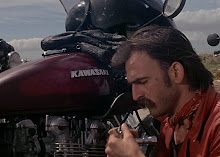Much to my amazement, the tempurature was already around 50 degrees when I woke up earlier this week. I figured the only real way to celebrate this wonderous change of the season was to hit the road on my Triumph.
Man, it's good to be back!
After looking at all of that snow and longingly looking at my bike while I grab the snow-blower, it was good to be out there. It was good to smell the smells and feel that wind in my face, even if it was still a little chilly.
I didn't head in any particular direction but did end up stopping at a neat little bookstore. And of course, I bought a book about motorcycles.
It's called Spanish Post-War Road and Racing Motorcycles by Mick Walker. It follows the rise and fall of the large Spanish motorcycles companies-Bultaco, Derbi, Montesa, Ossa and Sanglas-and gives a few details about the smaller companies.
Spain's motorcycle industry and history is quite interesting.
The rapid growth of the industry is due in large part to dictator Generalissimo Fransisco Franco's policies. Franco (who is still dead, by the way) placed large controls on imports which allowed the fledgling industry to thrive.
In the 15 or so years following the end of WWII, the Spanish motorcycle industry went from nothing to a major motorcycle-producing power. The Spanish companies also exported their motorcycles to the rest of Europe and to North America in large numbers.
During the 1960's, the motorcycle industry faced an economic downturn and intensified competition from car manufacturers like SEAT. This left only the strong companies like Bultaco, Derbi, Montesa, Ossa and Sanglas in business.
The 1970's signaled the end of the line for the Spanish companies. The nail in the coffin, quite literally, was the death of Franco in 1975. With his death, the strict import regulations were lifted and Spain was flooded with imports. The Spanish were now able to buy larger, faster and better motorcycle from any number of companies.
Slowly, the Spanish marques started to die off or were bought by foreign companies. Ossa and Bultaco were among the first to fold. Montesa was bought by Honda and is still a subsidiary. Mototrans was bought by Yamaha. Derbi is now a subsidiary of Piaggio, the makers of the Vespa scooter.
Today, the largest Spanish-owned motorcycle company is Gas Gas. They were formed with the remnants of Bultaco in 1985. They specialize in motocross and trials motorcycles and are the only Spanish company that still exports to North America.
The Spanish industry was built around a simple premise: cheap, reliable transportation. The majority of the bikes produced during the glory years were quite similar. The formula was: take a simple, small-capacity two-stroke single cylinder engine and build a small, lightweight motorcycle around it.
It's qiute sad to see a once strong and vibrant motorcycle industry such as the Spanish no longer in existance. The Spanish made some unique machines that deserve a place next to the storied marques from Britain, Italy and Germany.
This is a Montesa Impala Sport 250. It has 26 horsepower and a 4 speed gearbox. It's also really good-looking.
This is a 1969 Bultaco Metralla MKII. This could be called Spain's superbike. It had a 244cc single, 27 horsepower and a 5 speed gearbox.
Bikes like this 1974 Bultaco Sherpa T, built during the motocross boom in the 1970s, helped keep the Spaniards on life-support a little longer.
This is a 1965 Ossa 175 Sport. It has very Italian styling, similar to something from MV Agusta or Ducati.
And the modern Spanish motorcycle: a Derbi GPR125. It shares its engine with the Yamaha TZR125. It follows the traditional Spanish motorcyle formula: small single cylinder two-stroke engine surrounded by a lightweight motorcycle. It's good to see some things never change.






No comments:
Post a Comment